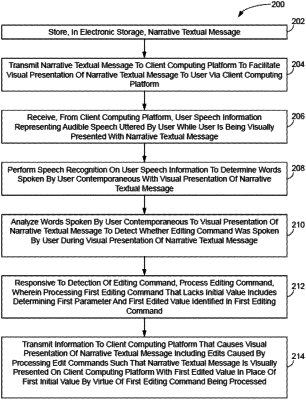| CPC G10L 15/22 (2013.01) [G06F 40/166 (2020.01); G10L 15/30 (2013.01); G10L 2015/223 (2013.01)] | 15 Claims |

|
6. A method of providing an interface for textual editing through speech, the method comprising:
storing, in electronic storage, a narrative textual message, the narrative textual message defining a state of a message object, wherein the message object is a medical patient, the narrative textual message expressing parameter values for parameters that describe the state of the medical patient, wherein the parameter values record individual assessments and/or measurements of the parameters taken with respect to the medical patient such that the parameter values of the parameters define the state of the medical patient, the parameters including a first parameter;
transmitting the narrative textual message to a client computing platform to facilitate visual presentation of the narrative textual message to a user via the client computing platform, wherein the user s a caregiver of the medical patient;
receiving, from the client computing platform, user speech information representing audible speech uttered by the user while the user is being visually presented with the narrative textual message;
performing speech recognition on the user speech information to determine words spoken by the user contemporaneous with visual presentation of the narrative textual message, wherein the words spoken by the user include i) a spoken parameter identifier that denotes the first parameter and an initial value to the first parameter or a lack of the initial value to the first parameter, and ii) an edited value;
analyzing the words spoken by the user contemporaneous to visual presentation of the narrative textual message to detect whether an editing command was spoken by the user during visual presentation of the narrative textual message, wherein the editing command includes i) the spoken parameter identifier and ii) the edited value, wherein an editing command indicates a request for an edit to the initial value of the first parameter or the lack of the initial value of the first parameter expressed in the narrative textual message with the edited value for the first parameter;
responsive to detection of the editing command, processing the editing command, wherein processing the editing command includes identifying:
(a) the first parameter and (b) the edited value present in the words spoken by the user,
wherein identifying the first parameter includes (i) comparing the spoken parameter identifier with individual ones of the parameters included in the narrative textual message to determine whether the spoken parameter identifier is one of identical to or denotes one of the parameters included in the narrative textual message, and (ii) responsive to determining the spoken parameter identifier is not identical to but denotes the first parameter, correlate the spoken parameter identifier with the first parameter to identify the spoken parameter identifier as a candidate parameter identifier for the first parameter, wherein the candidate parameter identifier semantically corresponds to the first parameter,
wherein processing the editing command that includes the lack of the initial value includes editing the narrative textual message by inserting the edited value for the first parameter, and wherein processing the editing command that includes the initial value includes editing the narrative textual message by replacing the initial value for the first parameter with the edited value; and
transmitting information to the client computing platform that causes visual presentation of the narrative textual message including edits caused by processing the editing command such that the narrative textual message is visually presented on the client computing platform with the edited value included by virtue of the editing command being processed.
|